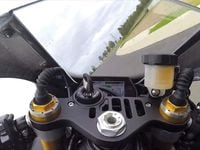The first task for any rider to accomplish when entering a corner is to determine its shape: Is it a wide-open sweeper? A hairpin? Or is it one of the countless variations between those two extremes?
This is a priority because, once in the corner, the bike is following an arc. The path of that arc is usually different than the curvature of the corner itself; that’s why we call it a cornering line. The challenge of finding a good line partially stems from the fact that a corner’s shape and radius are its most easily observable characteristics. Our eyes and instincts naturally guide us to follow that curvature, but this is not necessarily always the best line.
At 5 mph, that instinctual guidance would work fine. A tight path right around the inside of the curve would indeed be the best line. At higher speeds, however, riding parallel to a corner’s radius—right in the middle of the lane, all the way through—is seldom an optimum line. What is an optimum line, then?
To answer this question, first consider a common error, typified by a rider who fixedly tracks the inside edge of a corner for clues about its character. Let’s say the turn changes from tight to open and back to tight again. What will he or she do?
A less-skilled rider might make multiple steering and throttle corrections in that corner, based on distance from the inside edge. As the edge closes in, the rider might straighten the bike up some and dip the gas. As it recedes away, opening up, the rider will often lean in more and add some gas. As it tightens up, the first part of the scenario plays out again.
When a rider reacts to the corner in this fashion, the corner dictates the line. This is riding by survival instincts or what we call “survival reactions.” What information goes in through the eyes comes out, unfiltered, as control inputs through the arms.
How does this change if, instead of just following the corner as is, the rider instead takes that important first step of determining the corner’s shape before entering it? In practice, and as a standard to plot your line through most corners, it would be correct to say the line that demands the least number of control corrections is the best line. But we would be misleading ourselves to think plotting this line is a simple or easy process.
This is caused in part by the fact that, being on an arc, we must be able to predict the resulting path of travel through the corner. Like shooting a basketball through a hoop, the arc has to be predicted just right. Corners don’t have hoops to shoot for; consequently, the rider must use good judgment to choose the line that will complete the turn with the fewest possible corrections of speed and lean.
My purpose is to draw attention to your perception of your trajectory through the corner. Just as you enlist this when shooting a basket, it is an essential part of the art of cornering. Certainly this is more complicated when riding than when shooting baskets: Once the bike is traveling on an arc through the corner, you are part of the motion; you are not standing and watching it happen before you. To maintain the metaphor, once the bike is on an arc, you are the basketball.
Cultivating an awareness of your cornering arc, especially the portion from entry to apex, will engender substantial improvement in your confidence and smoothness. Practice this by: 1) targeting your apex, 2) steering the bike decisively at the turn-in point, and 3) allowing the bike to go where it goes, without steering corrections (unless this is dangerous, of course). Practice will make perfect.











/cloudfront-us-east-1.images.arcpublishing.com/octane/FZXHNOQRNVA3BIDWAF46TSX6I4.jpg)
/cloudfront-us-east-1.images.arcpublishing.com/octane/JRSFLB2645FVNOQAZCKC5LNJY4.jpg)
/cloudfront-us-east-1.images.arcpublishing.com/octane/ITNLTIU5QZARHO733XP4EBTNVE.jpg)
/cloudfront-us-east-1.images.arcpublishing.com/octane/VZZXJQ6U3FESFPZCBVXKFSUG4A.jpg)
/cloudfront-us-east-1.images.arcpublishing.com/octane/QCZEPHQAMRHZPLHTDJBIJVWL3M.jpg)
/cloudfront-us-east-1.images.arcpublishing.com/octane/HXOUJXQWA5HBHGRO3EMJIGFMVI.jpg)

/cloudfront-us-east-1.images.arcpublishing.com/octane/3TIWWRV4JBBOLDVGRYECVVTA7Y.jpg)
/cloudfront-us-east-1.images.arcpublishing.com/octane/KIX5O23D5NAIBGFXBN3327DKZU.jpg)
/cloudfront-us-east-1.images.arcpublishing.com/octane/7GJYDUIPXRGMTMQKN6ONYOLBOU.jpg)
/cloudfront-us-east-1.images.arcpublishing.com/octane/MUQLOVLL2ZDGFH25ILABNBXKTI.jpg)
/cloudfront-us-east-1.images.arcpublishing.com/octane/TNOU5DNE2BC57MFPMGN2EIDXAM.jpg)
/cloudfront-us-east-1.images.arcpublishing.com/octane/GTCXACQGJ5HAPDTGWUQKDEH44E.jpg)
/cloudfront-us-east-1.images.arcpublishing.com/octane/S35YGSEMEZB4BLTDJTSZPF4GLA.jpg)
/cloudfront-us-east-1.images.arcpublishing.com/octane/5UOT6HPX2JFMRJAX6EH45AR4MQ.jpg)
/cloudfront-us-east-1.images.arcpublishing.com/octane/OKWOJWAKP5EP3OACCRRWPCIX2Q.jpg)
/cloudfront-us-east-1.images.arcpublishing.com/octane/2WF3SCE3NFBQXLDNJM7KMXA45E.jpg)
/cloudfront-us-east-1.images.arcpublishing.com/octane/G4MG6OUCJNBSHIS2MVVOTPX65E.jpg)
/cloudfront-us-east-1.images.arcpublishing.com/octane/IIGGWFOTOJGB7DB6DGBXCCMTDY.jpg)
/cloudfront-us-east-1.images.arcpublishing.com/octane/QSTCM6AVEZA5JJBUXNIQ3DSOF4.jpg)
/cloudfront-us-east-1.images.arcpublishing.com/octane/U4I7G625B5DMLF2DVIJDFZVV6M.jpg)
/cloudfront-us-east-1.images.arcpublishing.com/octane/B6XD6LS6IVCQPIU6HXDJSM3FHY.jpg)
/cloudfront-us-east-1.images.arcpublishing.com/octane/ICL63FEDDRDTTMINYICCEYGMDA.jpg)
/cloudfront-us-east-1.images.arcpublishing.com/octane/FCGZHQXRBZFLBAPC5SDIQLVF4I.jpg)